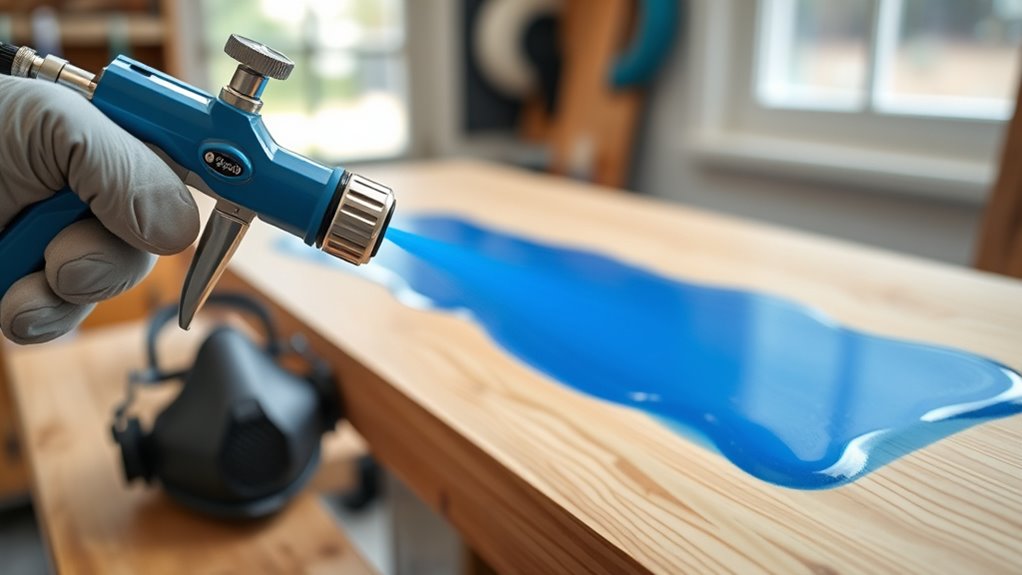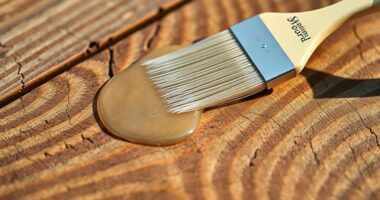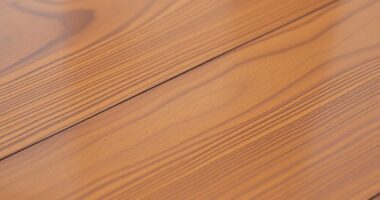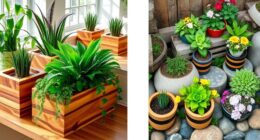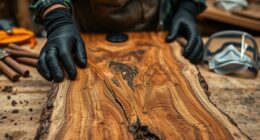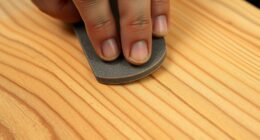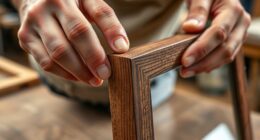To spray finish at home with an HVLP sprayer, start by setting up in a well-ventilated area and following the manufacturer’s instructions for assembly. Adjust the air cap and pressure to achieve even spray patterns, practice on scrap before starting your project, and keep the gun about 6-12 inches from the surface. Always wear a respirator and goggles, and cover surfaces to catch overspray. Proper maintenance and safety habits make certain professional results—keep going to learn more tips for safe, effective finishing.
Key Takeaways
- Ensure proper workspace ventilation, wear respirators and goggles, and cover surfaces to maintain safety during HVLP spray finishing.
- Adjust air cap and pressure settings to achieve the desired spray pattern and even coverage.
- Hold the spray gun 6-12 inches from the surface, overlapping passes for smooth, professional results.
- Regularly inspect and maintain equipment for leaks or damage to ensure safety and quality finishes.
- Practice consistent hand movements and spray techniques to minimize overspray and achieve uniform coating.
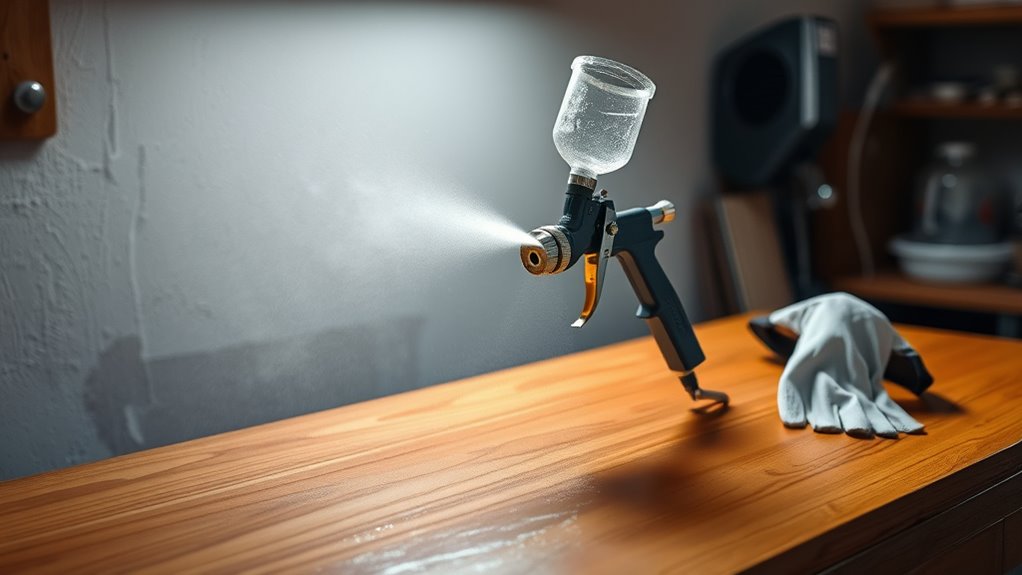
Have you ever wanted to achieve a professional-quality finish on your DIY projects without leaving your garage? If so, mastering spray finishing with an HVLP (High Volume Low Pressure) setup can make a huge difference. The key to a great finish lies in understanding how air flow and spray patterns interact. When you use an HVLP sprayer, controlling the air flow is vital because it determines how the paint is atomized and deposited on your surface. Too much air flow can cause overspray and drips, while too little might lead to uneven coverage. Adjusting the air cap and pressure settings allows you to fine-tune the spray pattern—whether it’s a narrow, focused jet or a wide, sweeping mist. Properly matching the spray pattern to your project helps guarantee even coats and reduces waste.
Getting the hang of spray patterns takes some practice, but it’s worth the effort. Most HVLP sprayers offer adjustable nozzles that let you change the spray width. When practicing, hold the gun at a consistent distance—usually about 6 to 12 inches from the surface—and move it smoothly across the area. Overlapping each pass by about 50% prevents streaks and uneven spots. It’s essential to keep the spray pattern consistent, which means controlling your hand movements and maintaining steady pressure. As you become more comfortable, you’ll notice that even coverage and minimal overspray are achievable, giving your projects a professional look. Additionally, familiarizing yourself with support hours can help if you encounter equipment issues or need technical assistance.
Safety should always be a priority when spray finishing at home. Make sure your workspace is well-ventilated to avoid inhaling fumes and overspray. Wearing a respirator mask designed for paint fumes protects your lungs, especially during long sessions. Eye protection is equally important—safety goggles keep paint splatters out of your eyes. Cover nearby objects and floors with drop cloths to catch overspray and keep your workspace tidy. Also, check your equipment regularly for leaks or damage, and always follow the manufacturer’s instructions for safe operation. Proper setup and maintenance not only protect your health but also guarantee consistent results.
Frequently Asked Questions
Can I Use HVLP Sprayers for Outdoor Projects?
Yes, you can use HVLP sprayers for outdoor projects. They provide a smooth, even finish that enhances outdoor durability and weather resistance. Just make certain you choose the right type of paint or finish suited for outdoor conditions, and apply it in suitable weather, avoiding high humidity or rain. Properly cleaning your sprayer afterward also helps maintain its performance, ensuring your outdoor projects last longer and withstand the elements.
What Paint Types Are Compatible With HVLP Systems?
You can use various paint types with HVLP systems, but always check paint compatibility first. Water-based acrylics and latex paints work well for most projects, providing smooth finishes and easy cleanup. Oil-based paints are also compatible but require more ventilation and cleanup. Thin thicker paints with appropriate reducers to guarantee proper atomization. Remember, the finish type you desire influences your choice—glossy, matte, or satin—so select paints suited to your desired result.
How Do I Clean and Maintain My HVLP Sprayer?
To keep your HVLP sprayer in top shape, follow a consistent maintenance schedule and use proper cleaning techniques. After each use, disassemble the parts and rinse them with appropriate solvents or water, depending on your paint type. Regularly check for clogs or wear, lubricate moving parts, and store the sprayer in a clean, dry place. This routine guarantees ideal performance and longevity of your HVLP system.
Is Special Ventilation Needed During Spray Finishing?
Think of spraying like breathing fresh mountain air; you want to keep it pure. Yes, special ventilation is needed during spray finishing. Use proper air filtration and dust control measures to prevent fumes and overspray from spreading. A well-ventilated space maintains you safe and ensures a smooth finish. Always work in a designated area with good airflow, and consider using exhaust fans or respirators for added protection.
What Are the Common Troubleshooting Tips for HVLP Setups?
If you’re troubleshooting your HVLP setup, start by checking the spray pattern; it should be even without sags or drips. Adjust the air pressure according to your project’s needs—too high can cause overspray, too low may result in uneven coating. Clean the nozzle and filter regularly to prevent clogs. Also, guarantee your paint consistency is correct, and inspect hoses for leaks or damage to maintain ideal performance.
Conclusion
Spray finishing at home is like mastering a dance—you need the right steps, tools, and safety measures. I once rushed my project without proper setup and ended up with a messy, uneven finish. That taught me the importance of patience and preparation. Remember, investing time in your HVLP setup and safety isn’t just about avoiding mishaps; it’s about creating a professional-looking result you’ll be proud of. With care and practice, your projects will truly shine.
